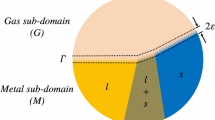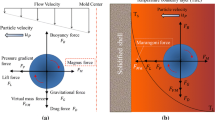Abstract
A mathematical model to analyse some key aspects of the metal cast process is described involving the filling of the mould by liquid metal and simultaneously, undergoing both cooling and solidification (re-melting) phase change. A computational solution procedure based upon a finite volume discretisation approach, on both structured and unstructured meshes, is described. The overall flow solution procedure is based on the pressure correction algorithm SIMPLE suitably adapted to: (a) solve for the free surface with minimal smearing by the SEA algorithm, and (b) solve for the solidification/melting phase change using an enthalpy conservation algorithm developed by Voller, but with its root in the work of Crank many years ago.
Similar content being viewed by others
References
C. Bailey, P. Chow, M. Cross, Y. Fryer and K. Pericleous, Multiphysics modelling of metals casting processes, Proc. Roy. Soc. London Ser. A 452 (1996) 459–486.
J. Campbell,Castings (Butterworth-Heinemann, Oxford, 1991).
CFDS-FLOW3D (AEA Technology, Harwell, Oxon, UK).
K. S. Chan, Free surface flow and application to the filling and solidification of liquid metals into vessels of arbitrary shape, Ph.D. thesis, University of Greenwich, London (1994).
P. M. Y. Chow, Control volume unstructured mesh procedure for convection-diffusion solidification process, Ph.D. thesis, University of Greenwich, London (1993).
J. Crank,Free and Moving Boundary Problems (Clarendon Press, Oxford, 1984).
M. Cross and J. Campbell, eds.,Modeling of Casting, Welding and Advanced Solidification Processes VII (Materials, Metals and Minerals Society, Warrendale, PA, 1995).
S. E. Hibbert, N. C. Markatos and V. R. Voller, Computer simulations of moving interface, convective, phase change process, Internat. J. Heat Mass Transfer 31 (1988) 1785–1795.
B. P. Leonard, Universal limiter for transient interpolation modelling of the advective transport equations, Tech. Memo 100916, NASA Lewis, Cleveland, OH (1988).
A. Lazaridis, A numerical solution of the multi-dimensional solidification (or melting) problems, Internat. J. Heat Mass Transfer 13 (1970) 1459–1477.
J. C. Martin and W. J. Moyce, An experimental study of the collapse of liquid column on a rigid horizontal plane, Philos. Trans. Roy. Soc. London Ser. A 244 (1952) 312.
T. T. Maxwell, Numerical modelling of free surface flows, CFDU, Ph.D. thesis, Imperial College, London (1977).
S. V. Patankar and D. B. Spalding, A calculation procedure for heat, mass and momentum transfer in three-dimensional parabolic flows, Internat. J. Heat Mass Transfer 15 (1972) 1787.
K. A. Pericieous, K. S. Chan and M. Cross, Free surface flow and heat transfer in cavities: the SEA algorithm, Numerical Heat Transfer, Part B 27 (1995) 487.
PHOENICS (CHAM Limited, Wimbledon, London, UK).
PHYSICA (University of Greenwich, London, UK).
W. H. Press, S. A. Teukolsky, W. T. Vetterling and B. P. Flannery, eds.,Numerical Recipes in Fortran, The Art of Scientific Computing (Cambrigde University Press, 1992) chapter 19.
C. M. Rhie and W. L. Chow, A numerical study of the turbulent flow past an isolated aerofoil with trailing edge separation, AIAA J. 21 (1982) 1525–1532.
P. Sampson and R. D. Gibson, Solidification of a liquid metal flowing through a circular pipe: a prediction of nozzle blockage, Adv. Engrg. Software 3 (1981) 17–25.
P. Sampson and R. D. Gibson, A mathematical model of nozzle blockage by freezing — II. Turbulent flow, Internat. J. Heat Mass Transfer 25 (1982) 119–126.
D. B. Spalding, A method for computing steady and unsteady flows possessing discontinuities of density, CHAM Report 910/2 (1974).
B. van Leer, Towards the ultimate conservation difference scheme, IV. A new approach to numerical convection, J. Comput. Phys. 23 (1977) 276.
V. R. Voller and M. Cross, Solidification processes, algorithms and codes, in:Mathematical Modelling of Materials Processing, eds. M. Cross et al. (Oxford University Press, Oxford, 1993) pp. 93–111.
V. R. Voller and C. Prakash, A fixed grid numerical modelling methodology for convection/diffusion mushy region phase change problems, Int. J. Heat Mass Transfer 30 (1987) 1709–1718.
V. R. Voller, C. R. Swaininathan and B. G. Thomas, Fixed grid techniques for phase change problems — a review, Internat. J. Numer. Methods Engrg. 30 (1990) 875–898.
Author information
Authors and Affiliations
Additional information
Dedicated to Professor J. Crank on the occasion of his 80th birthday
Rights and permissions
About this article
Cite this article
Pericleous, K.A., Cross, M., Moran, G. et al. Free surface Nvier-Stokes flows with simultaneous heat transfer and solidification/melting. Adv Comput Math 6, 295–308 (1996). https://doi.org/10.1007/BF02127709
Issue Date:
DOI: https://doi.org/10.1007/BF02127709




